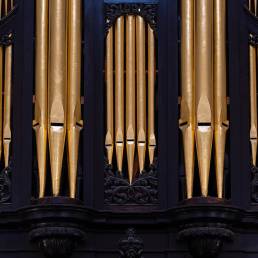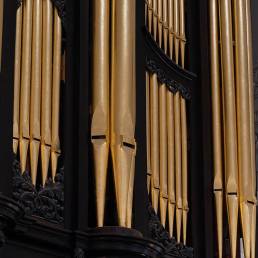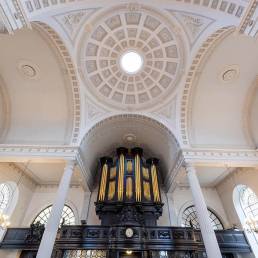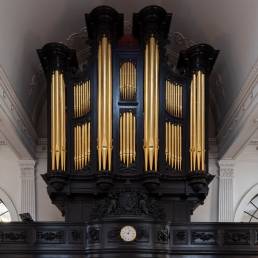Acknowledged as one of ten
most important organs in the UK
Acknowledged as one
of ten most important
organs in the UK
Central to St Mary-at-Hill is the church organ, acknowledged as one of ten most important organs in the UK built and installed in 1848 by William Hill, one of the leading organ-makers of the 19th century.
Holding special significance in the history of organ-building in Britain, the organ at St Mary-at-Hill was noted particularly for its use of the “German System” with having a key compass which started at C, together with a full pedal board and a case design which was strongly reminiscent of Father Smith four tower cases.
Following a disastrous fire which engulfed the church on the 10th May 1988, most of the roof, as well as much of the interior and parts of the organ were destroyed. After initial restoration work, funds unfortunately became exhausted and the organ languished in storage for ten years with little further work being undertaken. In 1999 however funds provided by the Heritage Lottery Fund enabled the organ to be fully restored to complete working order in 2000.
William Hill’s organ originally only had two manuals, however a third manual, a Choir Organ, was later added by Thomas Hill who worked on the organ in 1879-1880, which was placed on the gallery outside the confines of the case.
Further significant restoration work was also undertaken on the organ in 1971 by Hill Norman and Beard, where almost all of the original pipework and soundboards were preserved, as well as most of the drawstop and key action. At this time the Choir Organ was updated to a more traditional neo-classical design, and attempts were made to lighten the notoriously heavy key action using aluminium pallets and other action parts. The bellows were also placed out of action, and “schwimmers” were also incorporated into the bottoms of the soundboards.
At a later date it was decided that the organ should be restored closely to its original two manual scheme, with initial hopes that the original soundboards may be restored. It was later discovered however that as some of the soundboards were completely missing, and others had been so badly damaged through investigations, restoration was unfortunately not an option. Despite this set back sufficient material still remained, including almost all the upperboards, which enabled a fairly faithful reconstruction under strict traditional guidelines. The tables, slides and bearers, together with all the usual soundboard components are constructed from solid timber and no form of slider seal is employed. The rollerboards, which likely date back to Thomas Hill’s work, were also restored and new trackers of old design were made to replace the aluminium trackers of the 1971 work.
When the first restoration work initially started on the organ the original front pipes were replaced with new ones, which meant that the existing pipes were removed above the mouths, the upper portions discarded, and the lower portions kept as a pattern for new pipes. In addition, there were a number of interior pipes which had also been completely destroyed and although new materials were required to restore them to their original form, upon analysis it was revealed that the pipework was made of almost 96 per cent lead.
Updates included a new casting gauge which was made with special heat-resisting material, modifications to the casting bench, as well as changes to the casting technique. “Impurities” were also added to the mix in attempt to render the material more stable than a pure tin-lead metal version would be.



